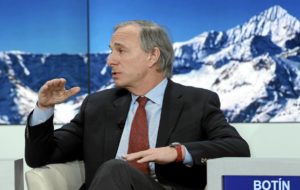
Ray Dalio predicted Tuesday that economic “pain” will become so significant that central banks will be forced to take a less aggressive approach toward monetary policy by 2024.
“We believe that we are in a tightening mode that can cause corrections or downward moves to many financial assets,” the Bridgewater Associates founder said in an interview with The Australian Financial Review. “The pain of that will become great and that will force the central banks to ease again, probably somewhere close to the next presidential elections in 2024.”
The Federal Reserve enacted a 25-basis point interest rate hike in March — a quarter of a percentage point — and raised it by a half-percentage point in May. The Fed is set to meet again from June 14-15, when it is expected to raise the rate by another half-point. Stock and cryptocurrency prices reacted by plummeting violently on both occasions.
The hikes come even as consumer debt rose to an all-time record high of $4.57 trillion in April. The figure increased by $38.1 billion for the month, outpacing forecasters’ expectation by $3 billion, and amounting to a year-over-year increase of 10.1 percent. The Fed is expected to continue hiking hikes on a monthly basis for the rest of the year, meaning consumers will see their payments on debt service rise significantly — despite being less liquid than they have ever been before.
Cleveland Federal Reserve Bank President Loretta Mester said this week that she wanted to see half-point hikes continue beyond September if inflation failed to decline. “My starting point will be, do we need to do another 50 [points], or not, have I seen compelling evidence that inflation is on that downward trajectory, then maybe we can go to 25” points, she said in an interview with CNBC. “I’m not in the camp that thinks we need to stop in September.”
Observers widely expect the Fed to target an interest-rate level of 2.5 percent by the end of the year. That target would require at least three more 50-basis point hikes between June and December, as well as a quarter-point hike, or some combination of those numbers over a slightly longer period.
Yet, to date, the hikes have been impotent against spiraling inflation, indicating the Fed may opt to move even more aggressively. Treasury Secretary Janet Yellen said in a Senate hearing on Tuesday that she expected the Biden administration to increase its forecast for inflation this year, suggesting that its current figure of 4.7 percent was too low.
Kim Dotcom Sounds Alarm on the Economy: The Future Will be ‘Worse than Most Can Imagine’
“It is a structural inflation situation that is going to produce stagflation,” Dalio said, before advising investors to dump cash and bonds. “There is going to be a great deal more spending than there will be earnings. There will be deficits. That will continue for a long time and for that reason, we don’t want to be in cash or bonds. There are assets to hold during a tightening and there are assets to hold during an easing. And in both cases, right now, we don’t want to own debt assets. We favor inflation-hedged assets.
“The debt that’s being held as assets by bondholders, and by holders of money market funds, will have a significantly negative return after adjusting for inflation,” he added. “That causes them to want to sell that debt and move him into other assets have a better return. And that produces a big supply-demand imbalance, which causes either real rates to rise a lot, which causes an economic and market downturn, or the central bank has to print more money to make up for that supply demand.”

 Bitcoin
Bitcoin  Ethereum
Ethereum  Tether
Tether  XRP
XRP  Solana
Solana  Dogecoin
Dogecoin  Cardano
Cardano  Chainlink
Chainlink  Avalanche
Avalanche  Polkadot
Polkadot  Monero
Monero  Cronos
Cronos  Aave
Aave  Algorand
Algorand  Tezos
Tezos  Axie Infinity
Axie Infinity  Polygon
Polygon  Onyxcoin
Onyxcoin  Golem
Golem  Flux
Flux